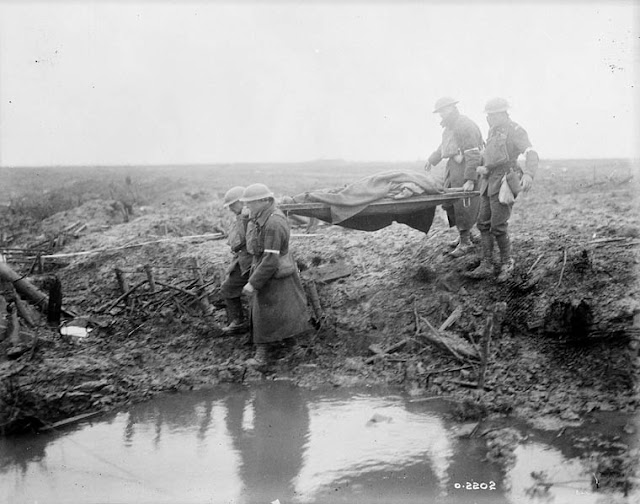The misery of World War One is a recurring theme in this blog, with the implicit question "how could they make anyone go through this hell?". Today we have a new installment, from a new source. The majority of World War One photographs here have been official British photographs (from the National Library of Scotland), made within specific guidelines to be published in the press. While there are nonetheless some striking action shots, and the overall misery can't be denied, their depictions of the war are heavily influenced by the vision the government wanted to project--a), that these men are heroes, and b) overall it's not that bad. Most action scenes are posed and/or performed for the camera in back-line trenches. Well-fed and smiling faces are emphasized, as are peaceful scenes. Most photographs of wounded soldiers emphasize the care they are given. Dead bodies are always identified as Germans; the British dead are pictured only in graves. We've looked also at some Australian WWI photographs, American ones, and even French autochromes, all fitting into this trend.
Recently, though, I found a set of Canadian WWI photographs, from Library and Archives Canada (who are on Flickr, but not the Commons). Though the named photographers-- William Ivor Castle, Henry Edward Knobels, and William Rider-Rider-- were official photographers, there seem to be quite a few different kinds of views. Notably there are more action shots, taken under fire, more similar to later photojournalist war photography. (even if, as should be noted, shots were sometimes altered-- shrapnel bursts from one photograph's sky might have been added to that of a another). Overall there seems to be a more frank depictions of the honesty of war than in the British official photographs, which I feel is worth a long look.
 |
| Library and Archives Canada |
Troops dig themselves in while shrapnel bursts overhead, Vimy Ridge, 1917. Source
 |
| Library and Archives Canada |
A tank in a muddy, shelled landscape, Passchendaele, 1917. Source
 |
| Library and Archives Canada |
The battlefield near Courcelette, October 1916. Source
 |
| Library and Archives Canada |
Troops advancing under a German barrage east of Arras, 1918, photographed by Rider-Rider. Source
 |
| Library and Archives Canada |
A machine gun emplacement at the crest of newly-captured (and dearly fought for) Vimy Ridge, 1917. Source
 |
| Library and Archives Canada |
Canadians advancing at Arras; one man appears to be running over to check on the body off the path. Source
 |
| Library and Archives Canada |
I'm not entirely sure what this caption is saying, so I'll quote it fully: "A Canadian cyclist shouting down a dug-out in German for men to come out." Arras, 1918. Source
 |
| Library and Archives Canada |
Armoured cars going into action at Amiens, 1918. Source
 |
| Library and Archives Canada |
Soldiers bring wounded to a field dressing station at the Battle of Vimy Ridge, April 1917. Source
 |
| Library and Archives Canada |
"Fox holes" in a trench on the front. Source
 |
| Library and Archives Canada |
Soldiers advance through the barbed wire and heavy fire of No Man's Land during the battle of Vimy Ridge, April 1917. Photographed by Henry Edward Knobel. Source
 |
| Library and Archives Canada |
Canadians enter the burning square in Cambrai, 1918. Photographed by William Rider-Rider. Source
 |
| Library and Archives Canada |
Strecher bearers en route to an aid post, Passchendaele, 1917. Source
 |
| Library and Archives Canada |
A soldier with mustard gas burns. Source
 |
| Library and Archives Canada |
A shell bursting near a solider in a trench, 1916. Photographed by Henry Edward Knobel. Source
 |
| Library and Archives Canada |
The first Canadian platoon to enter Valenciennes from the west, 1918. Photographed by Rider-Rider. Source
 |
| Library and Archives Canada |
The mud and barbed wire of Passchendaele, 1917. Photographed by William Rider-Rider. Source
 |
| Library and Archives Canada |
A bombed road at the Somme, 1916. Source
 |
| Library and Archives Canada |
Horse ambulance collecting wounded at an advanced dressing station, the Somme, 1916. Source
 |
| Library and Archives Canada |
First aid is given to a wounded soldier, 1918, photographed by William Rider-Rider. Source
 |
| Library and Archives Canada |
A severe case of trenchfoot, 1917. Source
 |
| Library and Archives Canada |
Advanced reserves digging themselves in under shell fire, Vimy Ridge, 1917. Source
 |
| Library and Archives Canada |
Machine gun personnel hold the line in shell holes during the Battle of Passchendaele, November 1917, photographed by William Rider-Rider. Source
 |
| Library and Archives Canada |
No Man's Land in front of Canadian lines, 1916, photographed by W. I. Castle. Source
 |
| Library and Archives Canada |
Stretcher bearers and German prisoners bring in wounded at Vimy Ridge, 1917. Source
 |
| Library and Archives Canada |
The admission area of No. 2 Canadian General Hospital, 1916, photographed by Edward Kidd. Source
 |
| Library and Archives Canada |
Seveteen-year-old Private Lawrence, wounded fifteen minutes before the Armistice. Photographed by Rider-Rider. Source
 |
| Library and Archives Canada |
The battlefield of Passchendaele, 1917. Photographed by Rider-Rider. Source

1 comment:
That poor gas soldier! Looks like he had to be propped up to get the picture. Interestingly his picture is also on the wiki article about mustard gas. Since it looks like his face was burned, I'd guess he also had respiratory burns. Wonder if he made it?
Post a Comment